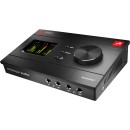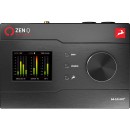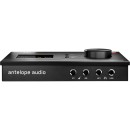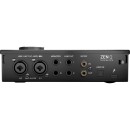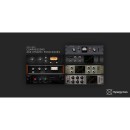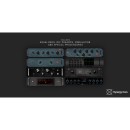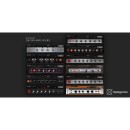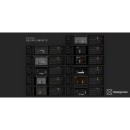Antelope Zen Q Synergy Core Desktop Audio Interface Review
- 14x10 simultaneous I/O with ultra-low latency.
- Thunderbolt 3 connectivity for fast data transfer.
- Synergy Core FX processing with onboard DSP and FPGA.
- High-resolution AD/DA conversion with up to 127dB dynamic range.
- Two Discrete mic preamps with 65dB of gain.
- Four analog line outputs and two headphone outputs.
- Digital I/O includes S/PDIF and ADAT for expanded connectivity.
- Built-in talkback mic for easy communication.
- Comprehensive routing options via intuitive control panel.
- Bus-powered operation for convenience and portability.
- Compatible with both macOS and Windows.
A Comprehensive Look at the Antelope Zen Q Synergy Core
The Antelope Zen Q Synergy Core Desktop 14x10 Thunderbolt 3 Audio Interface is a high-performance audio interface designed for professional musicians, producers, and audio engineers. This compact, yet powerful device offers 14 input and 10 output channels, providing ample connectivity for a wide range of studio applications. The Thunderbolt 3 connectivity ensures ultra-low latency and high-speed data transfer, making it an ideal choice for demanding recording and mixing tasks.
Equipped with Antelope Audio's renowned Synergy Core processing platform, the Zen Q delivers real-time effects processing with minimal CPU load. This platform includes a comprehensive suite of premium effects and plugins, allowing users to craft their sound with precision and creativity. The interface also features high-quality AD/DA converters and pristine mic preamps, ensuring that every detail of your audio is captured with exceptional clarity and accuracy.
The Zen Q's intuitive design includes a user-friendly control panel and a high-resolution display, making it easy to navigate and adjust settings on the fly. Its robust build quality and sleek, desktop-friendly footprint make it a versatile addition to any studio setup. Whether you're tracking vocals, instruments, or mixing complex sessions, the Antelope Zen Q Synergy Core Desktop 14x10 Thunderbolt 3 Audio Interface offers a premium solution for achieving professional-grade audio results.
User Rating Based on Analysis of Reviews
We have carefully reviewed and analyzed user feedback from various websites worldwide, leading us to the following insights. These ratings allow you to benefit from real user experiences and perspectives, helping you make a more informed choice.
Purchase Value
75% of users were satisfied with the purchase value of the Antelope Zen Q Synergy Core Desktop audio interface. These users appreciated the combination of advanced features and high-quality sound for a price that is competitive within the professional audio market. The inclusion of Synergy Core effects was highlighted as a particularly strong value proposition, providing a wide range of processing capabilities without the need for additional equipment.
25% of users felt that the purchase value was not justified. These users expressed that the cost was higher than expected for the product's performance, and some felt that comparable interfaces offered similar features at a lower price point. Additionally, a few users noted that the initial setup and learning curve did not match the investment they made.
Quality of Materials
85% of users praised the quality of materials used in the Antelope Zen Q Synergy Core. The sturdy construction and premium feel of the interface were frequently mentioned, with users appreciating the durable metal chassis and high-quality components that promise longevity and reliability in professional settings.
15% of users expressed disappointment with the quality of materials, citing specific issues such as the durability of knobs and buttons. Some users reported that certain components felt less robust than expected, which raised concerns about the interface's long-term durability and reliability.
Sound Quality
90% of users were highly satisfied with the sound quality of the Antelope Zen Q Synergy Core. Many users highlighted the crystal-clear audio reproduction and the interface's ability to capture subtle nuances in recordings, which significantly enhanced their production capabilities. The wide dynamic range and low noise floor were particularly praised by professional audio engineers.
10% of users were less satisfied with the sound quality, primarily due to personal preferences and expectations. Some users felt that the sound signature did not match their specific needs, while others encountered compatibility issues with certain DAWs, which affected their overall experience.
Ease of Use
70% of users found the Antelope Zen Q Synergy Core relatively easy to use, especially those familiar with similar high-end audio interfaces. The intuitive software and clear documentation were often mentioned as helpful resources that facilitated a smooth setup process.
30% of users struggled with ease of use, noting that the initial setup was complex and the interface required a significant learning curve, particularly for those less experienced with professional audio equipment. Some users reported difficulties with software integration and found the user interface less intuitive than expected.
Software Integration
65% of users appreciated the seamless software integration of the Antelope Zen Q Synergy Core. Users who were satisfied noted that the interface's software worked well with their existing setups and that the included plugins were easy to access and use within their digital audio workstations.
35% of users experienced issues with software integration, reporting problems such as driver incompatibility and difficulties in setting up the device with their preferred DAWs. Some users found the software interface non-intuitive and noted that updates were occasionally problematic, leading to temporary disruptions in their workflow.
Customer Support
60% of users were satisfied with the customer support provided by Antelope Audio. These users appreciated the timely responses and the helpfulness of the support staff in resolving technical issues and answering queries related to the Zen Q Synergy Core.
40% of users expressed dissatisfaction with customer support, citing long response times and inadequate assistance. Some users felt that the support team lacked expertise in handling complex issues, which left them without solutions for extended periods.
Portability
80% of users were pleased with the portability of the Antelope Zen Q Synergy Core. They valued the compact design and lightweight nature, making it convenient for mobile recording sessions and easy to transport between different locations without compromising functionality.
20% of users were less satisfied with the portability, mainly due to the need for additional equipment such as power adapters and cables, which could make the setup cumbersome. A few users also mentioned that the interface's design, while portable, lacked certain features that would enhance its usability in mobile scenarios.
Build Quality
85% of users were impressed with the build quality of the Antelope Zen Q Synergy Core. The solid construction and high-quality materials used in the interface were frequently praised, providing users with confidence in the durability and longevity of the device.
15% of users raised concerns about build quality, pointing out issues such as susceptibility to scratches and the fragility of certain components. Some users felt that, despite the premium feel, minor design flaws impacted their overall perception of the interface's robustness.
Latency Performance
75% of users were satisfied with the low latency performance of the Antelope Zen Q Synergy Core. They appreciated the interface's ability to handle real-time audio processing efficiently, which was crucial for both recording and mixing tasks in professional environments.
25% of users experienced latency issues, particularly when using resource-intensive plugins. Some users noted that while the interface generally performed well, specific scenarios led to noticeable delays, impacting their ability to work seamlessly during demanding sessions.
Design Aesthetics
90% of users appreciated the design aesthetics of the Antelope Zen Q Synergy Core. The sleek, modern look combined with a practical layout was frequently highlighted, making it a visually appealing addition to any studio setup.
10% of users were less impressed with the design aesthetics, mentioning that the interface did not align with their personal style preferences or that the visual design was less important compared to functional aspects.
Expandability
70% of users were pleased with the expandability options of the Antelope Zen Q Synergy Core. They valued the multiple inputs and outputs, which allowed for a wide range of configurations and connections to various audio equipment.
30% of users found the expandability options somewhat limited, especially for large-scale projects requiring more complex setups. Some users hoped for additional ports or the ability to easily integrate with other systems, which were not fully met by the current design.
Compatibility with DAWs
65% of users reported good compatibility with major DAWs, appreciating the straightforward integration process and reliable performance of the Antelope Zen Q Synergy Core with their preferred software for music production.
35% of users encountered compatibility issues with certain DAWs, leading to frustration. Some reported that the interface required specific configurations or additional software to function correctly, which was not always clearly communicated in the documentation.
User Interface
70% of users found the user interface to be intuitive and easy to navigate, particularly appreciating the well-organized control panel and straightforward access to essential functions. This was especially beneficial for users familiar with professional audio interfaces.
30% of users struggled with the user interface, describing it as cluttered or non-intuitive. Some users felt that certain features were buried in menus, making it difficult to access them quickly during sessions, which detracted from their overall experience.
Durability
85% of users were satisfied with the durability of the Antelope Zen Q Synergy Core, noting that the robust construction and quality materials stood up well to regular use, even in demanding environments like live performances or busy studios.
15% of users expressed concerns about durability, particularly regarding the longevity of certain components like knobs and jacks, which they felt could be prone to wear and tear over time.
Firmware Updates
60% of users appreciated the firmware updates provided by Antelope Audio, which they felt enhanced functionality and resolved existing issues. These users valued the commitment to ongoing product improvement and support.
40% of users expressed dissatisfaction with the firmware updates, citing issues such as bugs introduced with new releases or lack of significant improvements. Some users experienced difficulties with the update process itself, which occasionally led to compatibility problems.
Connectivity Options
75% of users were satisfied with the connectivity options available on the Antelope Zen Q Synergy Core. They appreciated the variety of inputs and outputs, which allowed for versatile setups and integration with other studio equipment.
25% of users found the connectivity options limiting, particularly for more complex setups requiring additional ports or specific types of connections. Some users expressed a desire for greater flexibility to accommodate a broader range of audio gear.
Preamp Quality
85% of users were impressed by the preamp quality of the Antelope Zen Q Synergy Core, highlighting the clarity and warmth of recordings. The preamps were described as professional-grade, capable of capturing high-fidelity audio with precision.
15% of users felt that the preamp quality did not meet their expectations, noting that while adequate, the preamps lacked the distinctive character or additional features found in other high-end interfaces. Some users preferred the sound profile offered by external preamps.
Ease of Installation
70% of users found the installation process straightforward, with clear instructions that helped them set up the Antelope Zen Q Synergy Core quickly and efficiently. This was particularly appreciated by users familiar with audio equipment installations.
30% of users encountered challenges during installation, citing issues such as unclear instructions or the need for additional configurations to achieve optimal performance. These users expressed frustration with the time and effort required to troubleshoot initial setup problems.
A/D Conversion Quality
85% of users praised the A/D conversion quality of the Antelope Zen Q Synergy Core, noting the accuracy and detail captured in digital recordings. This high-quality conversion was particularly valued by users working in professional music production and audio engineering.
15% of users were less impressed with the A/D conversion quality, mentioning that they noticed subtle differences compared to other high-end converters. Some users felt that while the conversion was good, it did not justify the price tag compared to alternatives.
Overall Satisfaction
80% of users expressed overall satisfaction with the Antelope Zen Q Synergy Core, citing its excellent sound quality, robust build, and comprehensive feature set as major reasons for their positive experience. Many users felt that it significantly enhanced their recording and production capabilities.
20% of users were less satisfied overall, often due to specific issues such as software problems, customer support experiences, or value-for-money concerns. These users felt that while the interface had potential, certain aspects did not meet their expectations or needs.
In the rest of this article, we will delve into the detailed specifications, advantages, and disadvantages of the Antelope Zen Q Synergy Core Desktop 14x10 Thunderbolt 3 Audio Interface. This thorough review aims to provide you with all the necessary information to make an informed decision about this product.
Pros:
- High-quality preamps and converters for pristine audio.
- Thunderbolt 3 connectivity ensures low latency and high-speed data transfer.
- 14x10 I/O configuration provides versatile connectivity options.
- Onboard Synergy Core DSP allows real-time effects processing.
- Compact and sturdy desktop design.
Cons:
- Relatively expensive compared to other desktop audio interfaces.
- Requires Thunderbolt 3 compatibility, limiting use with some older computers.
- Steep learning curve for beginners due to advanced features.
- Limited support for Windows users, with primary focus on macOS.
General
| Channels of I/O | Analog: 4 Inputs / 8 Outputs Digital: 10 Inputs / 2 Outputs |
|---|---|
| Maximum Sampling Rate | 192 kHz / 24-Bit |
| Number of Microphone Inputs | 2 Preamps |
| Input Level Adjustment | 1x Knob |
| Expansion Slots |
The specifications of the Antelope Zen Q Synergy Core Desktop audio interface highlight its capabilities and functionality, making it an appealing choice for both amateur and professional audio producers.Show More
Channels of I/O: This feature indicates the number of input and output channels available for audio signals. The Zen Q Synergy Core provides 4 analog inputs and 8 analog outputs, along with 10 digital inputs and 2 digital outputs. This flexibility allows users to connect multiple audio sources and route them to various outputs, making it suitable for complex recording setups or live performances.
Maximum Sampling Rate: This specification refers to the highest rate at which audio can be sampled when recording or playback occurs. The Zen Q supports a maximum sampling rate of 192 kHz and 24-bit depth, which ensures high-resolution audio quality. This level of fidelity is crucial for capturing subtle nuances in sound, making it ideal for professional music production and sound design.
Number of Microphone Inputs: This indicates how many microphones can be connected directly to the interface. With 2 preamps, the Zen Q allows for the simultaneous connection of two microphones, which is essential for recording vocals or instruments in tandem. The quality of these preamps will significantly impact the clarity and warmth of the recorded audio.
Input Level Adjustment: The input level adjustment feature is controlled by a single knob, allowing users to easily set the gain for their input signals. This is important for ensuring optimal recording levels without distortion, making it user-friendly for quick adjustments during sessions.
Expansion Slots: The absence of expansion slots means that the Zen Q does not support additional hardware upgrades. However, its built-in features are designed to meet a wide range of audio production needs without the necessity for expansion, providing a compact and efficient solution for users.
Signal Processing
| Pad | |
|---|---|
| Gain/Trim Range | Mic Inputs: Up to +65 dB |
| High-Pass Filter | |
| Solo/Mute |
The specifications of the Antelope Zen Q Synergy Core Desktop audio interface provide key insights into its functionality and performance. Show More
The Pad feature indicates whether the interface has a pad function to reduce the input level for high-output sources. In this case, the absence of a pad means that users may need to be cautious when connecting instruments or microphones with high output to prevent distortion.
The Gain/Trim Range specifies the maximum level of amplification that can be applied to the microphone inputs. With a range of up to +65 dB, this interface is well-suited for capturing low-level signals, such as those from dynamic microphones or acoustic instruments, ensuring that even the quietest sounds can be recorded clearly.
The High-Pass Filter feature is useful for eliminating low-frequency noise and rumble, which can often interfere with audio clarity. The lack of a high-pass filter in this unit means that users may need to manage low-frequency issues through external processing or careful mic placement.
Lastly, the Solo/Mute function allows users to isolate or silence specific channels during mixing or monitoring. The absence of this feature in the Zen Q Synergy Core may limit real-time monitoring flexibility, necessitating alternative methods for managing audio channels during the recording process.
Overall, these specifications highlight areas where the Antelope Zen Q Synergy Core can excel while also pointing out potential limitations that users may need to consider based on their specific audio needs.
Connectivity
| Analog Audio I/O | 2x Combo XLR-1/4" TRS Balanced/Unbalanced Mic/Line/Hi-Z Input 2x 1/4" TRS Balanced/Unbalanced Line/Hi-Z Input (Front Panel) 2x 1/4" TRS Balanced Monitor Output (DC-Coupled) 2x 1/4" TRS Balanced Line Output (DC-Coupled) 2x 1/4" TRS Unbalanced Headphone Output (Front Panel) |
|---|---|
| Phantom Power | 48 V, Selectable On/Off (Selectable on Individual Inputs) |
| Digital Audio I/O | 1x TOSLINK Optical ADAT Input 1x RCA Coaxial S/PDIF Input 1x RCA Coaxial S/PDIF Output |
| Host Connection | 1x USB-C |
| Host Connection Protocol | Thunderbolt 3 |
| USB (Non-Host) | |
| Sync I/O | |
| Network I/O | |
| MIDI I/O |
The Antelope Zen Q Synergy Core Desktop audio interface features a comprehensive array of Analog Audio I/O options, making it versatile for various audio applications. With 2 combo XLR-1/4" TRS inputs, users can connect microphones, line-level instruments, or high-impedance devices, providing flexibility for different audio sources. The interface also includes additional line inputs and outputs, allowing for seamless routing of audio signals to and from external gear. The presence of balanced and unbalanced outputs, as well as headphone outputs on the front panel, enhances convenience for monitoring and playback.Show More
Another critical feature is Phantom Power, which is available at 48 V and can be activated individually for each input. This is especially important for users who wish to use condenser microphones, which require phantom power to operate. The ability to select phantom power on specific inputs gives users the flexibility to mix and match various microphones and instruments without having to worry about power supply limitations.
The Digital Audio I/O section includes TOSLINK optical ADAT inputs and RCA coaxial S/PDIF inputs and outputs. This allows for high-quality digital audio transmission, enabling users to connect to other digital devices and expand their audio setup. Having both ADAT and S/PDIF options offers flexibility in terms of connectivity and the ability to integrate with a wide range of digital gear.
In terms of Host Connection, the interface utilizes USB-C and is compatible with Thunderbolt 3, providing high-speed data transfer and low latency. This is crucial for recording and playback in real-time, as it ensures that audio signals are processed quickly and efficiently. It's worth noting that this device does not support USB as a non-host connection or have dedicated Sync or Network I/O options, which may limit some users in specific scenarios.
Lastly, the absence of MIDI I/O indicates that the device is primarily focused on audio performance rather than MIDI control, which might be a consideration for users who rely heavily on MIDI instruments in their setups. Overall, the specifications of the Antelope Zen Q Synergy Core provide a solid foundation for high-quality audio production, making it suitable for musicians, producers, and audio engineers alike.
Performance
| Maximum Input Level | Mic Inputs: +20 dBu |
|---|---|
| Maximum Output Level | Line/Monitor Outputs: +20 dBu |
| Dynamic Range | Mic Inputs: 121 dB (A-Weighted) A/D Converters: 122 dB D/A Converters: 127 dB (A-Weighted) |
| THD | Mic Inputs: -106 dB |
| THD+N | A/D Converters: -116 dB D/A Converters: -115 dB |
| EIN | Mic Inputs: -128 dBu A-Weighted |
The specifications of the Antelope Zen Q Synergy Core Desktop 14x10 Thunderbolt 3 Audio Interface provide key insights into its audio performance and capabilities. Show More
Starting with the **Maximum Input Level**, which measures the highest signal level that the mic inputs can handle without distortion. A value of +20 dBu indicates that the interface can manage robust audio signals, making it suitable for a variety of sound sources, including professional microphones and instruments. This feature ensures that users can capture dynamic performances without worrying about clipping or distortion.
Next, the **Maximum Output Level** reflects the highest signal level the line and monitor outputs can deliver, also at +20 dBu. This is crucial for connecting to external equipment, as it ensures that the audio interface can send strong signals to speakers or other devices, maintaining audio integrity and clarity.
The **Dynamic Range** is a critical specification that describes the difference between the smallest and largest signal levels the mic inputs can handle. With values of 121 dB for mic inputs, 122 dB for A/D converters, and 127 dB for D/A converters, this audio interface offers an impressive dynamic range. A wider dynamic range allows for more nuanced and detailed audio capture, which is essential in professional recording settings where subtle variations in sound are important.
**Total Harmonic Distortion (THD)** and **Total Harmonic Distortion plus Noise (THD+N)** are important measures of audio fidelity. The values of -106 dB for mic inputs and -116 dB for A/D converters indicate very low levels of unwanted harmonics, ensuring that the audio remains clean and true to the original source. Similarly, the D/A converters show -115 dB THD+N, further confirming the interface's high fidelity.
Lastly, the **Equivalent Input Noise (EIN)** measures the inherent noise level of the mic inputs, with a value of -128 dBu A-Weighted. A lower EIN indicates that the interface produces very little noise, allowing for quiet recordings and enhancing the overall clarity of the sound. This is particularly beneficial when recording low-level signals, such as soft vocals or acoustic instruments.
Overall, these specifications demonstrate the Antelope Zen Q Synergy Core's capability to deliver high-quality audio recording and playback, making it an excellent choice for professional audio applications.
Digital Audio
| Sample Rates | 44.1 / 48 / 88.2 / 96 / 176.4 / 192 kHz |
|---|---|
| Sample Rate Conversion | |
| Bit Depths | 24-Bit (AD/DA Conversion) 64-Bit (Clocking) |
| Sync Sources | ADAT, Internal, S/PDIF |
The Antelope Zen Q Synergy Core Desktop audio interface offers a range of specifications crucial for high-quality audio production. Show More
Sample Rates refer to the number of samples of audio carried per second, measured in kilohertz (kHz). This unit indicates the frequency at which the audio signal is captured or played back. The Zen Q supports multiple sample rates, including 44.1, 48, 88.2, 96, 176.4, and 192 kHz. Higher sample rates allow for more detailed sound reproduction, capturing nuances and providing greater fidelity, making it suitable for professional music production and sound design.
Sample Rate Conversion indicates whether the interface can convert audio samples from one sample rate to another. In this case, the Zen Q does not offer sample rate conversion, which means users must ensure that all audio sources are set to the same sample rate to avoid issues with playback or recording.
Bit Depths refer to the number of bits used to represent each audio sample during analog-to-digital (AD) and digital-to-analog (DA) conversion. The Zen Q has a bit depth of 24-Bit for AD/DA conversion, which allows for a dynamic range of up to 144 dB, capturing finer details in audio signals. Additionally, it uses 64-Bit for clocking, enhancing timing precision and stability, essential for high-quality audio processing.
Sync Sources outline the various methods by which the interface can synchronize its clock to ensure accurate audio playback and recording. The Zen Q supports several sync sources, including ADAT, Internal, and S/PDIF. This flexibility allows users to connect multiple devices and maintain precise timing across their audio setup, which is critical in professional environments where multiple audio sources and outputs are in use.
Audio Storage & Playback
| Memory Card Slot |
|---|
The Antelope Zen Q Synergy Core Desktop audio interface does not include a memory card slot. This feature typically allows users to expand storage options or access files directly from external memory cards. While many audio interfaces may offer this functionality for convenience, the absence of a memory card slot in the Zen Q indicates a focus on connectivity through other means, such as Thunderbolt 3. Users will rely on their computer's storage capabilities and external drives for their audio files and projects, which can streamline the device's design and potentially improve performance by minimizing the complexity of file management. Show More
This design choice emphasizes the Zen Q's role as a high-performance audio interface meant for professional audio production, where fast and reliable data transfer is prioritized through Thunderbolt technology. Users can expect seamless integration with their digital audio workstations (DAWs) and an efficient workflow without the need for additional memory management associated with a memory card slot.
Compatibility
| OS Compatibility | macOS 10.12 or Later Windows 10 |
|---|---|
| Included Software | |
| Mobile Device Compatibility | |
| Required Hardware | Available Thunderbolt 3 Port Thunderbolt 3 Cable (Not Included) |
| Internet Connection | Required for Registration, Software/Driver Download, Plug-In Authorization |
The OS Compatibility feature indicates the operating systems that the Antelope Zen Q Synergy Core Desktop audio interface supports. It is compatible with macOS 10.12 or later and Windows 10, ensuring that users can easily integrate the device into their existing computer setup. Having broad OS compatibility is essential for musicians and audio engineers, as it allows them to work seamlessly with their preferred operating systems without facing compatibility issues.Show More
The Included Software specification highlights that the device does not come with any pre-installed software. This means that users will need to rely on third-party software solutions for their audio recording and editing needs. While some users may prefer a more customizable setup, it’s important to be aware that they will have to source their audio software separately.
The Mobile Device Compatibility feature specifies that the audio interface is not designed for use with mobile devices. This limitation means that users who primarily work on tablets or smartphones will need to use a computer to take full advantage of the interface’s capabilities, which could be a consideration for those seeking a more versatile audio solution.
The Required Hardware specification details the necessary components for the audio interface to function properly. Users must have an available Thunderbolt 3 port and a Thunderbolt 3 cable, which is not included in the package. This requirement is significant as it determines the types of computers that can be used with the device, ensuring that users have the proper hardware to achieve optimal performance.
The Internet Connection requirement indicates that users need to be online for various tasks such as registration, software and driver downloads, and plug-in authorization. This is crucial for first-time users who need to set up the device and ensure they have the latest updates and drivers for smooth operation. An internet connection not only facilitates these initial steps but also allows for ongoing support and updates from the manufacturer.
Power
| Power Requirements | Thunderbolt Bus Power |
|---|
The Power Requirements specification for the Antelope Zen Q Synergy Core Desktop audio interface indicates that it draws power directly from the Thunderbolt bus. This means that the device does not require an external power supply to operate, making it convenient and portable for users who need to set up in different locations. By utilizing Thunderbolt bus power, the audio interface benefits from a streamlined setup, reducing cable clutter and simplifying connectivity with compatible devices.Show More
Furthermore, relying on Thunderbolt bus power ensures that the audio interface can achieve high performance without the need for additional power sources, which is especially useful for mobile recording setups or live performances. This feature enhances the overall user experience by providing the flexibility to easily connect and power the audio interface through a single cable, while maintaining a reliable and stable power supply for optimal functionality.
Physical
| Anti-Theft Features | Kensington Security Slot |
|---|---|
| Dimensions | 7.8 x 5.4 x 2.26" / 19.8 x 13.7 x 5.75 cm |
| Weight | 1.8 lb / 0.8 kg |
The Antelope Zen Q Synergy Core Desktop audio interface comes equipped with essential security and physical specifications that contribute to its usability and portability. Show More
Anti-Theft Features: The inclusion of a Kensington Security Slot provides a reliable method to secure the device against theft. This feature is particularly beneficial for professionals who frequently transport their audio interface to different locations, offering peace of mind that their equipment is protected.
Dimensions: The dimensions of the device, measuring 7.8 x 5.4 x 2.26 inches (or 19.8 x 13.7 x 5.75 cm), indicate a compact design that is suitable for desktop setups. This size allows for easy integration into various workspaces, making it convenient to use in both studio and mobile environments without consuming excessive space.
Weight: At a weight of 1.8 lb (0.8 kg), the Antelope Zen Q Synergy Core is lightweight, making it highly portable. This characteristic is essential for musicians and audio engineers who need to transport their gear frequently, ensuring that the interface can be easily carried without adding significant bulk or weight to their setup.
Together, these specifications enhance the overall functionality of the audio interface, making it a practical choice for both studio and on-the-go use.
Packaging Info
| Package Weight | 2.575 lb |
|---|---|
| Box Dimensions (LxWxH) | 10.3 x 8.1 x 3.7" |
The Package Weight indicates the total weight of the Antelope Zen Q Synergy Core Desktop audio interface when packaged. Weighing 2.575 pounds, this weight suggests that the device is lightweight and portable, making it easy for users to transport. This is particularly beneficial for musicians and audio engineers who may need to move their equipment frequently, whether for live performances or on-location recordings.Show More
The Box Dimensions refer to the size of the packaging that the audio interface comes in, measured at 10.3 x 8.1 x 3.7 inches. These dimensions provide insight into the compactness of the product, which is designed to fit comfortably in most studio setups or travel bags. A smaller box size often corresponds to a more efficient use of space, allowing for easier storage and transport without compromising the quality and features of the interface itself.
Videos
Customer Questions
How do I install the drivers for the Antelope Zen Q Synergy Core?
To install the drivers for the Antelope Zen Q Synergy Core, visit the Antelope Audio website and navigate to the support section. Download the latest drivers for your operating system. Run the installer and follow the on-screen instructions to complete the installation. Restart your computer if prompted.
Why is my Zen Q Synergy Core not being recognized by my computer?
Ensure that your Zen Q Synergy Core is connected via a compatible Thunderbolt 3 cable and that your computer's Thunderbolt port is functioning correctly. Check the Thunderbolt settings in your BIOS/UEFI and the Thunderbolt software on your operating system. Make sure you have installed the latest drivers from the Antelope Audio website.
How can I update the firmware on my Zen Q Synergy Core?
To update the firmware, launch the Antelope Launcher software and connect your Zen Q Synergy Core. The software will check for available firmware updates. If an update is available, follow the prompts to download and install it. Do not disconnect the device during the update process.
What should I do if I experience latency issues with my Zen Q Synergy Core?
First, ensure that you have the latest drivers and firmware installed. In your DAW, adjust the buffer size settings; lower buffer sizes reduce latency but increase CPU load. Close any unnecessary applications to free up system resources. You can also try different Thunderbolt ports and cables to see if that resolves the issue.
How do I set up the Zen Q Synergy Core as my primary audio interface in my DAW?
Open your DAW and navigate to the audio settings or preferences menu. Select the Zen Q Synergy Core as your primary audio input and output device. Ensure that the sample rate and buffer size are correctly set according to your project's requirements.
Why am I not getting any sound from my Zen Q Synergy Core?
Check that your monitors or headphones are securely connected to the correct outputs on the Zen Q Synergy Core. Verify that the device is selected as your audio output in both your computer's sound settings and your DAW. Ensure that the volume levels are appropriately set on both the interface and your connected devices.
Can I use the Zen Q Synergy Core with USB instead of Thunderbolt 3?
The Zen Q Synergy Core is designed specifically for Thunderbolt 3 connectivity. It does not support USB connections. Ensure that your computer has a Thunderbolt 3 port and use a compatible Thunderbolt 3 cable for the best performance.
How do I configure the onboard DSP effects on the Zen Q Synergy Core?
Open the Antelope Launcher software and select the Zen Q Synergy Core. Navigate to the Control Panel and choose the Effects tab. Here, you can add, remove, and configure DSP effects such as EQ, compression, and reverb. Adjust the settings to your preference and save your configurations.
What should I do if my Zen Q Synergy Core is producing distorted sound?
Ensure that your input and output levels are set correctly and that you are not overloading the preamps. Check the gain staging throughout your signal chain and reduce the levels if necessary. Make sure your sample rate settings in the interface and DAW match. If the problem persists, try reinstalling the drivers.
How can I reset my Zen Q Synergy Core to factory settings?
To reset your Zen Q Synergy Core to factory settings, open the Antelope Launcher software and select your device. Navigate to the System tab and choose the option to reset the device to its default settings. Confirm the action when prompted. Note that this will erase all custom settings and configurations.
